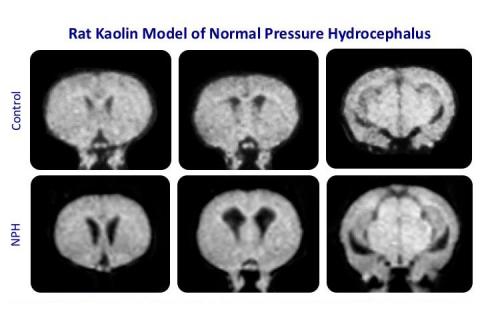The overall goal of this multi-disciplinary, cross-university project is to better understand and treat cerebrospinal fluid (CSF) disorders, and researchers are approaching this goal at multiple levels.
Currently, scientists have a rodent model of normal pressure hydrocephalus (NPH) in which they can examine what happens to brain circuits and behavior/cognition as hydrocephalus develops, and in which they can test possible treatment strategies.
Using the classic kaolin model of NPH, scientists have analyzed the effects of age of onset on cognition and other functions. Previously, a rat model of kaolin-induced hydrocephalus was shown to cause significant ventriculomegaly and anatomical changes involving hippocampal structures (Klinge et al, 2003) that are similar to those found in NPH patients. In this study, scientists employed this rat kaolin model to examine the cognitive and gait impairments associated with NPH and whether such deficits are more severe with age of onset.
Young and middle-aged male Long Evans rats were subjected to sham surgery or a procedure to induce hydrocephalus. After recovery, animals were tested on a battery of tasks to assess cognition and motor impairments including the 3-dimensional spontaneous object recognition (3D SOR), gait analysis, open field locomotor activity, and contextual fear conditioning. All rats underwent an MRI scan to verify ventricle size. Young and middle-aged NPH rats showed gait deficits including shortened stride length, increased number of falls, and increased stance duration (magnetic gait). Interestingly, in the 3D SOR task, recognition memory was significantly impaired in middle aged NPH animals, but not in the young NPH animals, suggesting that younger subjects show more resilience with respect to cognitive impairment.
In order to analyze gait deficits in their kaolin model, researchers developed a new gait analysis system. In early 2019, they were preparing a paper reporting validation of their gait analysis system using the haloperidol model of Parkinsonianism. Despite its importance of gait analysis in many areas of research, the available commercial and open source options have several limitations including high cost and lack of flexibility. To address these issues, researchers developed a new video analysis system for automated quantification of gait that uses a transparent floor to obscure objects not in contact with the surface and effectively isolate the rat’s paw prints as it walks. Scientists have analysis software that identifies the paw finds the centroid, identifies left and right, forepaws and hind paws, and calculates a dozen variables useful for gait analysis. Once published the instructions for the apparatus and the software will be open access.
Researchers are examining changes in brain oscillations associated with the onset of hydrocephalus. Interestingly, brain oscillations in the theta frequency band are altered in the EEG of patients with idiopathic NPH (Sao et al, 2014). NPH patients that responded to the shunting procedure showed increased power in several frequency bands including theta (Ikeda et al, 2015). So, perhaps theta alterations may underlie cognitive deficits. There is also evidence that theta coherence across these brain regions may be important for memory. Scientists have preliminary data that memory related brain regions show coherence in theta, and that theta coherence increases when normal rats are looking at objects in an object recognition task.
Furthermore, scientists are investigating whether the tap test or a shunt can improve cognitive deficits as well as theta power and/or coherence.
